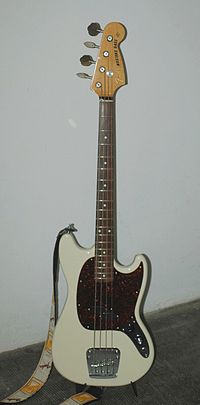List of manufacturers of electric basses and amplifiers
Below is a list of manufacturers of electric basses and electric bass amplifiers.
Manufacturer of electric basses
fender
As with the electric guitar , the Fender company was one of the pioneers in the field of electric bass. The Precision Bass , released in 1951 , which is still one of the most popular and most copied electric basses, was long considered the first solid-body bass. But in fact had Paul Tutmarcs company Audiovox manufacturing & Co such a bass before the Second World War built (see electric bass history ); Fender has been sued several times for its advertisement claiming to have built the world's first electric bass. However, Fender is probably the first company to produce such a bass in large numbers. The name Precision comes from the use of frets on the fingerboard, which was actually unusual at the time. With fretless basses, the precise gripping of the notes was a complicated undertaking, but with the frets it became "more precise".
Even if technically the step from the electric guitar to the electric bass seemed only small, the P-bass, as it is often called, was a completely new instrument and one for the development of modern rock and pop music real milestone. The classic rock trio with electric bass, electric guitar and drums would be inconceivable without this invention. Some details that were developed for this bass, such as the second cutaway , were later carried over to the Stratocaster guitar.
Since the Precision was only equipped with a single split coil pickup (a split single coil), its sound was naturally somewhat limited. This shortcoming was corrected in 1960 with the Jazzbass (J-Bass), which was equipped with two single coils and also brought some innovations in terms of design and handling. The jazz bass is still one of the most widespread and popular basses ever.
Even if Fender developed a few other bass models, such as the Telecaster Bass , they never caught on in the masses. To this day, Fender Precision and Jazzbass models are produced in a wide variety of designs.
The “Made in USA” version of the basses is available from 800 to 1000 euros, but the prices for older models (1960s) are often many times as much.
Gibson
While Gibson and Fender were one of the most important innovators in guitars, most bass models were not very lucky. The promising concepts usually failed due to individual construction details, such as the use of mahogany for the neck and body (EB-0, EB-3, Thunderbird), short lengths (EB-0, EB-3, viola bass), high-impedance pickups in unfavorable positions (EB-0) and non-functional bridges (EB-0, EB-3 , Thunderbird, G3, Grabber, Ripper), which generally resulted in a full, but almost always poorly defined sound. Even pure maple constructions (G3, Grabber, Ripper, RD Artist) and long-pitched basses (Thunderbird, Les Paul, Explorer) - some models even equipped with sophisticated active electronics (RD Artist, Victory) - remained, partly deserved, partly wrongly (due to the already damaged reputation) relatively unsuccessful. Gibson basses have always been able to maintain their loyal fan base and especially the models Thunderbird and EB-3 (the bass with which Jack Bruce redefined the bass playing at Cream ) are still very popular, because they with their unusual designs and their Cult sound represent a welcome alternative to the mainstream.
Hofner
The Höfner 500/1 model , also known as the violin bass, became very famous in the 1960s and is wrongly called a copy of the Gibson EB-1 bass. This is inaccurate because both instruments have a similar silhouette at best, but are fundamentally different in structure. While the first instruments ( mandolins ) were practically carved from solid wood blocks at Gibson in Kalamazoo / Michigan , the Franconian town of Bubenreuth was already the center of German string and plucked instrument making , where violin making was perfectly mastered. The Höfner violin bass, made legendary by its most prominent user Paul McCartney (therefore also known as the “ Beatles Bass”), reflects practically the entire know-how of violin making, whereas the Gibson EB-1, sawn from solid wood, was only used by bassists of the 1950s wanted to lure away from the double bass . This intention behind the instrument, which weighs more than 6 kilos, is also made clear by the supplied stand, which enabled plucking in a standing position in the double bass style. The Höfner violin bass (factory designation: 500/1), which has been built from 1956 to the present day with minor changes, is a short-scale bass with very narrow string spacings and a violin-shaped body that is accordingly comfortable to play, but one slightly undefined, muffled tone (vintage sound) with short sustain . In addition to the violin bass, Höfner also produced numerous basses which, apart from the club bass (500/2) and the shorty bass (187/2) introduced in 1982, did not attract any noteworthy attention on the market.
Rickenbacker
In the late 60s and early 70s the model 4001 from the manufacturer Rickenbacker became very popular, which, apart from its unusual design, with its continuous multi-part neck ( neck-thru ), special pickups and an idiosyncratic electronic concept (the two signals of the pickups , each of which amplifies certain frequency ranges, can be processed individually using a stereo output) also creates a unique, defined and aggressive sound. Because of this special sound, the Rickenbacker 4001 was mainly used in (progressive) rock, heard in the hands of Paul McCartney ( The Beatles , Wings ), Chris Squire ( Yes ), Geddy Lee ( Rush ), Roger Glover and Glenn Hughes ( Deep Purple ), Martin Turner ( Wishbone Ash ), Lemmy Kilmister ( Motörhead ), Cliff Burton ( Metallica ), Joey DeMaio ( Manowar ), Robert Byron Hardy ( Franz Ferdinand ) and many more.
Further manufacturers of electric basses
|
|
Manufacturer of electric bass amplifiers
|


